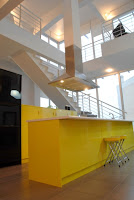The Royal Institute of Architects have handed out 93 prizes to 17 new educational buildings before new government cuts bite
In what may be the last hurrah for public buildings before government spending cuts bite,
prizes for architectural quality were awarded to 17 new school and university buildings by the Royal Institute of British Architects today.
From a £27m art and design academy at Liverpool John Moores University to a multicoloured glass extension at Clapham Manor primary school, education buildings won almost a fifth of the RIBA's 93 awards in a feat that may not be repeated for a generation after the government ordered a moratorium on new plans for school buildings.
The new education secretary, Michael Gove, recently clashed with architects when he accused them of "creaming off cash" that should have been going to the frontline.
The RIBA roll of honour also reveals the damaging effect of recession on architectural opportunity: instead of the stadium, airport and museum projects of previous years, the 2010 list features more modest projects, including a bus drivers' toilet in Dagenham and a black-clad electricity sub-station on a 2012 Olympic site in east London. And, with house building falling to an 87-year low, just three housing schemes were granted awards.
Many of the country's leading designers, including Zaha Hadid, David Chipperfield and Rogers Stirk Harbour & Partners, won accolades for buildings elsewhere in the EU rather than at home. Hadid's expressionist angles and curves were reserved for Rome's museum of 21st-century art,
MAXXI, while Lord Rogers, widely regarded as one of the world's leading modernists, designed a new headquarters campus for a Spanish technology company in Seville.
"The RIBA awards reflect not only the state of British architecture but also that of its economy," said Ruth Reed, the institute's president. "In the midst of the deepest recession in the awards' 45-year history, this year demonstrates that, although times might be hard for architects, there are still great buildings being built throughout the country and overseas. The RIBA awards always give an opportunity for gem-like small projects and less established practices to shine through, and this year is no exception. Far from being a size prize, the RIBA awards are for buildings that offer value to people's lives."
The memorial in Hyde Park to the victims of the 7 July 2005 bomb attacks on the London transport network, by
Carmody Groarke, also won and is considered by some as a possible contender for the shortlist for the £20,000 Stirling prize for building of the year, which is drawn from the RIBA award winners.
Ellis Woodman, architecture critic at the newspaper Building Design, said that other strong Stirling prize contenders included the Nottingham contemporary arts centre, the new British embassy in Warsaw, the Neues Museum in Berlin, Christ's College school in Guildford and Hadid's MAXXI museum.
The Oregon-born architect
Rick Mather won most awards, gaining four. Other winning buildings included a new home in Bristol for Wallace and Gromit's creators, Aardman Animations, and a cluster of foil-clad small-business units, which look like cybermen helmets, designed by Thomas Heatherwick, in Wales.
























